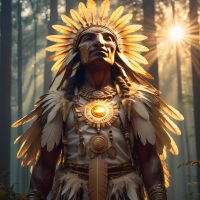Hashtahli : The Sun God
Listen
At a glance
| Description | |
|---|---|
| Origin | Choctaw Mythology |
| Classification | Gods |
| Family Members | N/A |
| Region | United States of America |
| Associated With | Sun |
Hashtahli
Introduction
In Choctaw mythology, Hashtahli—often translated as “the sun that completes the action”—is a revered solar deity embodying light, order, and spiritual vitality. His name itself reveals his divine function: to sustain life and balance through the power of the sun. Regarded as both a physical and moral force, Hashtahli represents illumination in all its forms—bringing warmth to the land, clarity to human hearts, and guidance to the spirit world. His presence underscores the Choctaw belief that the universe operates through interconnected natural and spiritual laws, where celestial bodies embody divine intelligence and purpose. The sun, through Hashtahli, is not merely an object in the sky—it is a living spirit, a watchful protector, and a reminder of the eternal cycles of life and renewal.
Physical Traits
Descriptions of Hashtahli rarely take on human form, as his essence is considered too radiant and sacred to be seen directly. In the Choctaw worldview, he is the brilliance of the sun itself, an ever-burning orb of light whose face no mortal can look upon. Some oral traditions portray him as riding a great buzzard across the heavens—a symbolic image representing his daily journey from east to west and the cyclical order of nature. This majestic flight reflects not only the path of the sun but also the transformation between life and death, day and night. His brilliance symbolizes divine energy, purity, and enlightenment, concepts that guide both spiritual practice and moral behavior among the Choctaw people. In some ceremonial depictions, Hashtahli’s radiance is echoed through the use of fire, feathers, and gold tones to honor his eternal light and strength.
Family
Hashtahli’s celestial family plays a vital role in maintaining the balance of the cosmos. His consort is Hvashi or Hashi Ninak Anya, meaning “the little sun that shines at night,” known to the modern world as the moon goddess. Together they represent the duality and harmony between light and darkness, day and night. Their union gave birth to the stars—their daughters who adorn the sky each night. The Choctaw believed that when the moon disappears from the sky, she spends that time with Hashtahli, restoring her light and returning renewed. This poetic explanation of lunar phases illustrates how deeply cosmology and family structures are intertwined in Choctaw thought. Their myths express not only astronomical observations but also a profound reverence for natural rhythm and interdependence.
Other names
Within Choctaw oral tradition, Hashtahli is also known by several variant names and titles. He is sometimes referred to as Hashi Tali, meaning “Sun Above” or “Sun Father,” a name that emphasizes his role as a divine overseer. In certain traditions, Hashtahli is linked or even equated with Ababinili, the Choctaw Creator deity who embodies the essence of divine power, moral order, and creation itself. Scholars often interpret this as an example of theological fluidity, where the sun becomes both an aspect and a manifestation of the Supreme Being. Some stories also associate Hashtahli with Nanishta, a primordial spirit connected to creation. Each of these variations highlights a particular dimension of his divinity—whether as the cosmic ruler, fatherly guide, or embodiment of creative light.
Powers and Abilities
Hashtahli’s powers extend far beyond his role as the sun god. He governs all forms of light, warmth, and growth, ensuring the fertility of the earth and the rhythm of life. His heat nurtures crops and living beings, but his absence brings darkness and decline, making his cycles central to Choctaw agricultural and spiritual life. As the guardian of truth and justice, Hashtahli is believed to see all things that occur beneath his light. Because of his all-seeing nature, Choctaw people traditionally invoked him as a witness during solemn vows and moral oaths, trusting his presence to uphold honesty and virtue.
Another important aspect of Hashtahli’s mythology involves his battle during solar eclipses. In ancient Choctaw stories, a monstrous black squirrel attempts to devour the sun during these events. To defend Hashtahli, the Choctaw would make loud noises—beating drums, shouting, and firing weapons—to scare the creature away and restore light to the world. This ritual not only reflects their understanding of celestial phenomena but also their belief in communal action against forces of darkness and imbalance.
Hashtahli is also connected to the afterlife. In certain stories, his light guides departed souls along their path, acting as a psychopomp who helps spirits reach the realm beyond. The buzzard he rides across the sky is symbolic of purification and transformation, consuming decay so that life can begin anew—a sacred metaphor for death and rebirth.
Modern Day Influence
The legacy of Hashtahli remains alive in modern Choctaw identity, symbolizing continuity between ancient tradition and contemporary spirituality. His image as the sun father persists in Choctaw art, music, and storytelling, where the sun continues to represent hope, resilience, and moral clarity. The Nanih Waiya mound, often regarded as the sacred birthplace of the Choctaw people, aligns with solar patterns—serving as a physical testament to the tribe’s long-standing reverence for celestial cycles.
In contemporary times, Hashtahli’s teachings find renewed relevance in educational and cultural programs aimed at preserving Choctaw language and mythology. By teaching younger generations about their solar deity, the Choctaw Nation reinforces ecological awareness, ethical living, and cultural pride. Artists incorporate solar imagery into beadwork, paintings, and public installations, while storytellers adapt Hashtahli’s myths for modern audiences, linking ancient cosmology with present-day environmental consciousness.
Furthermore, Hashtahli’s enduring symbolism resonates beyond the Choctaw community, offering insight into indigenous perspectives on light, balance, and moral integrity. His story parallels those of other global solar deities—like Ra of Egypt or Surya of India—revealing humanity’s shared recognition of the sun’s sacred power. Yet, unlike many distant sun gods, Hashtahli’s myth remains intimate and relational: he is both cosmic and communal, both radiant and moral, ever watching over the Choctaw world.
Today, Hashtahli stands as more than a mythological figure—he embodies cultural survival, identity, and the unbroken connection between people and the natural world. Through his light, the Choctaw continue to find meaning, direction, and renewal, ensuring that the sun of their ancestors never sets.
Related Images
Source
Boucher, M. (2025). Choctaw Religion. Retrieved April 14, 2025, from https://mike-boucher.com/wordpress/?page_id=207
Boucher, M. (2025). Ancient Choctaw Calendar. Retrieved April 14, 2025, from https://mike-boucher.com/wordpress/?page_id=139
Boucher, M. (2025). Choctaw Legends & Stories 2. Retrieved April 14, 2025, from https://mike-boucher.com/wordpress/?page_id=232
Glitternight. (2012, June 2). The top twelve deities in Choctaw mythology. Retrieved from https://glitternight.com/2012/06/03/the-top-twelve-deities-in-choctaw-mythology/
Louisiana Anthology. (2013, November 5). Bushnell & Pisatuntema, Choctaw Myths. Retrieved from https://louisiana-anthology.org/texts/bushnell/bushnell–choctaw_myths.html
Folklore.Earth. (n.d.). Choctaw Mythology. Retrieved November 2025, from https://www.folklore.earth/culture/choctaw/
Hudson, C. (1976). The Southeastern Indians. University of Tennessee Press.
Mould, T. (2004). Choctaw Prophecy: A Legacy of the Future. University of Alabama Press.
Swanton, J. R. (1931). Source Material for the Social and Ceremonial Life of the Choctaw Indians. Bureau of American Ethnology, Bulletin 103.
Howard, J. H. (1990). Oklahoma Seminoles: Medicines, Magic, and Religion. University of Oklahoma Press.
Kidwell, C. S. (1995). Choctaws and Missionaries in Mississippi, 1818–1918. University of Oklahoma Press.
Frequently Asked Questions
What is lorem Ipsum?
I am text block. Click edit button to change this text. Lorem ipsum dolor sit amet, consectetur adipiscing elit. Ut elit tellus, luctus nec ullamcorper mattis, pulvinar dapibus leo.
What is lorem Ipsum?
I am text block. Click edit button to change this text. Lorem ipsum dolor sit amet, consectetur adipiscing elit. Ut elit tellus, luctus nec ullamcorper mattis, pulvinar dapibus leo.
What is lorem Ipsum?
I am text block. Click edit button to change this text. Lorem ipsum dolor sit amet, consectetur adipiscing elit. Ut elit tellus, luctus nec ullamcorper mattis, pulvinar dapibus leo.
What is lorem Ipsum?
I am text block. Click edit button to change this text. Lorem ipsum dolor sit amet, consectetur adipiscing elit. Ut elit tellus, luctus nec ullamcorper mattis, pulvinar dapibus leo.
What is lorem Ipsum?
I am text block. Click edit button to change this text. Lorem ipsum dolor sit amet, consectetur adipiscing elit. Ut elit tellus, luctus nec ullamcorper mattis, pulvinar dapibus leo.





